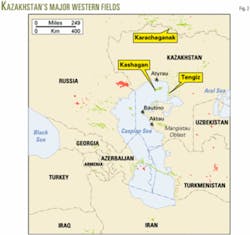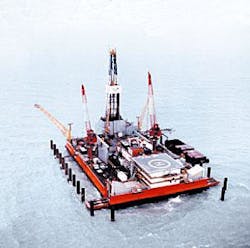Kazakhstan authorities earlier this summer impounded a Caspian Sea-based drilling barge over allegations of about $6 million in unpaid duties.
Houston-based Parker Drilling Co. owns Rig 257, the world's only arctic class drilling barge rig (Fig. 1). It was initially mobilized to the Caspian in 1999 to drill in the Kashagan field, and renamed Sunkar (meaning "falcon" in the Kazakh language) and demobilized to the port of Bautino in November 2003 to await further drilling (Fig. 2).
The rig owner, Houston-based Parker Drilling Co., was notified of the rig arrest on July 2, 2004, and filed objections to the duty assessment with the court in Aktau, Mangistau Oblast.
Parker Drilling spokesperson Rose Bratton told OGJ that the documentation provided in the court proceedings "demonstrates that we are exempt from these duties" and that "judicial review will result in the resolution of this dispute in our favor."
The Kashagan field is operated by a consortium of ENI SpA (16.9%), BG Group PLC (16.67%), Royal Dutch/Shell Group, Exxon Mobil Corp., Total SA, ConocoPhillips, and Inpex of Japan. BG has planned to sell its share of Kashagan, and both ENI and the Kazahstan government want to acquire this share.
The government claimed priority in late June, just days before the arrest of the Sunkar rig, suggesting that the rig impoundment is a strong-arm tactic.
Referring to the Kashagan reserves, Vladimir Shkolnik, Kazakhstan's minister of energy and mineral resources said, "The asset belongs to the state anyway."
Parker Barge Rig 257, "Sunkar," arrived in Kazakhstan in 2003 (Fig. 1; photo from Parker Drilling Co.).
null
Surrounding events
In December 2001, Kazakh President Nazarbayev signed the Energy Partnership Declaration with the US. In June 2002, the government of Kazakhstan issued a decree restricting oil and gas procurement.
On May 16, 2003, Nazarbayev approved a 12-year program of development for the Kazakhstan sector of the Caspian Sea, which would increase oil production to about 2.3 million bo/d by 2010.
Under the plan, KazMunaiGas, the national oil and gas company, involved in the development of both onshore and offshore fields, would have 50% share of all new oil projects in the Caspian.
According to Wood Mackenzie, Kazakhstan has 75% of the Caspian Sea remaining liquid reserves (OGJ, Dec. 17, 2001, p. 18).
The country has proven reserves of 16 billion bbl oil, more than 2% of the world's proven oil reserves.
Kazakhstan produced 358.4 million bbl in 2003, up from 330 million bbl in 2002, from three major fields: Tengiz (the name means "sea") and onshore Karachaganak (both discovered 1979), and offshore Kashagan field (discovered 2000).
Caspian drilling requires equipment tailored for deep, high-pressure reservoirs, with sour gas and other contaminants.
Tengiz had the longest uncontrolled blowout in Soviet history in 1986 and has accumulated nearly 5 million tons of sulfur from field production. However, the oil from both Tengiz and Kashagan fields is light, sweet crude (Tengiz 47.2º API).
Parker Drilling has six rigs in Kazakhstan. Three are drilling in the Tengiz field (107, 249, 258), one is drilling in the Karachaganak field (216), and two are warm-stacked (257, 259).
The Sunkar drilling barge was the only rig operating offshore. The company operates 43 rigs (including 5 barges) internationally and 31 rigs (including 21 barges) in the Gulf of Mexico.
In January 2003, Robert L. Parker Jr., president and chief executive officer, said "We are proud to be the largest Western drilling contractor in Kazakhstan."

